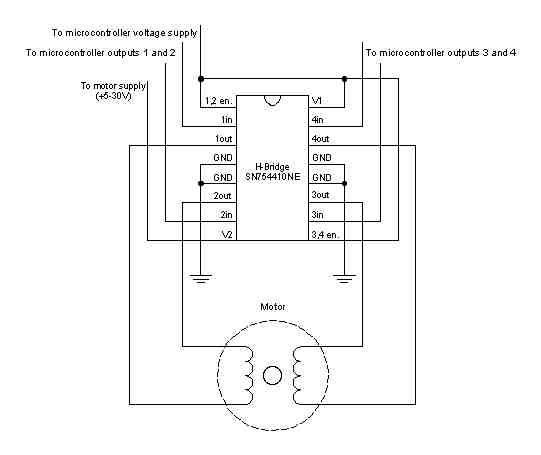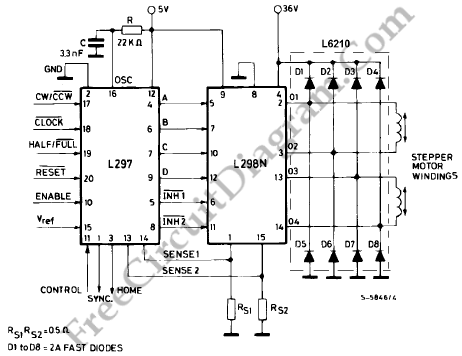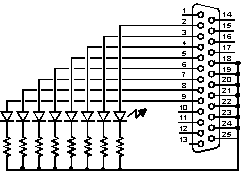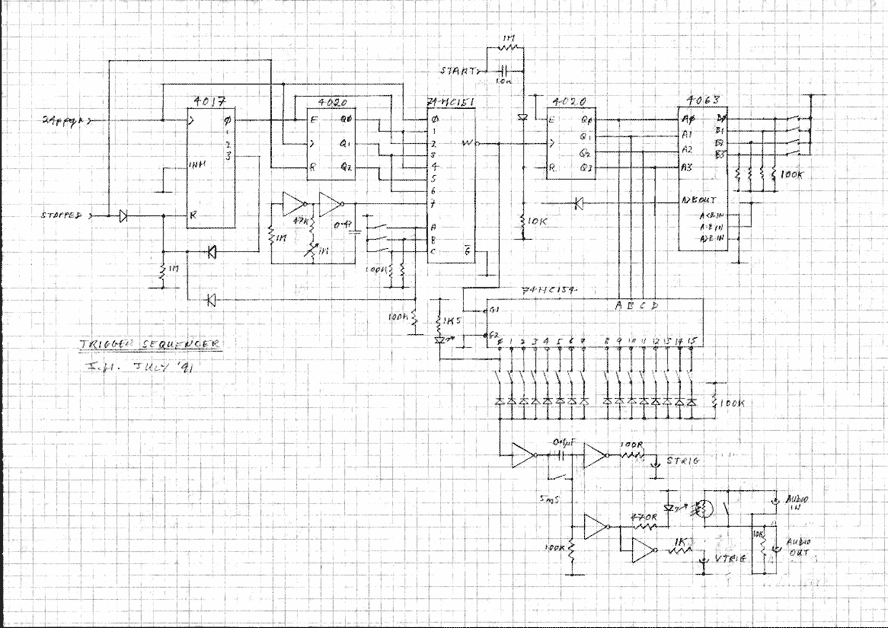
MIDI circuits
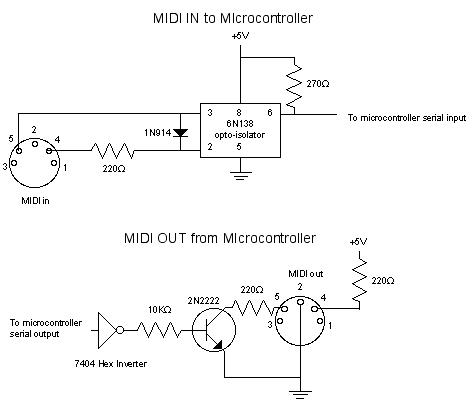
MIDI, or Musical Instrument Digital Interface, is a specification for a communications protocol between digital synthesizers and other digital music devices. It was developed to be as simple and general as possible, providing synthesizer manufacturers with significant flexibility while ensuring their instruments can communicate without issues. MIDI does not define the nature or timbre of a synthesized sound but describes the action of playing the sounds. In essence, MIDI serves as a markup language for synthesizers, similar to how HTML operates for the web. As a communication and control language for musical instruments, it is crucial for MIDI to be fast; delays in sound production would hinder user experience. This speed also makes MIDI useful for other interactive devices, providing an instantaneous response to user actions. While the MIDI protocol is relatively straightforward, it encompasses many intricate aspects that contribute to its power. The protocol operates at a speed of 31,250 bits per second, utilizing serial communication. Each byte consists of 8 bits, along with a start bit and a stop bit, and operates at 5 volts DC. The standard MIDI connector is a 5-pin DIN connector, typically with female connectors on devices and male connectors on MIDI cables. The hardware required for MIDI connections includes two 5-pin DIN female jacks, three 220-ohm resistors, one 270-ohm resistor, one 10-kohm resistor, one 1N914 diode, one 2N2222 NPN transistor, one 6N138 optoisolator, and one 7404 Hex inverter. The inverter may not be necessary if the serial device already performs the inversion. For certain microcontrollers, such as the BX-24, a simplified circuit can be utilized for MIDI output, as they can send non-inverted serial data. MIDI devices can be categorized into two groups: controllers, which send MIDI messages, and receivers, which respond to those messages. Many synthesizers function as both controllers and receivers. MIDI devices are connected in chains, allowing up to 16 receivers to respond to messages sent to their respective channels while ignoring others. Each MIDI command typically consists of at least two bytes: a status byte and a data byte, with the most common messages comprising three bytes. MIDI values are expressed in hexadecimal notation for convenience, with status bytes having values of 128 or greater and data bytes ranging from 0 to 127. This structure allows synthesizers to easily identify the nature of the information from the first bit of a message.
MIDI operates as a universal protocol for electronic musical instruments, facilitating communication between devices such as keyboards, synthesizers, and computer software. The standard MIDI message format includes various commands that dictate actions like note on/off, pitch bending, and control changes. Each command is initiated by a status byte that specifies the type of message, followed by one or two data bytes that provide additional information, such as the note number and velocity.
The protocol's architecture allows multiple devices to be connected in a daisy chain configuration, enhancing the versatility of MIDI setups. Each device in the chain is assigned a unique channel, enabling them to selectively respond to specific messages while ignoring others. This multi-channel capability allows for complex arrangements where multiple instruments can be controlled simultaneously from a single controller.
The hardware implementation of MIDI requires careful attention to the circuit design, particularly regarding the use of resistors and the proper configuration of the DIN connectors. The inclusion of components like the optoisolator serves to protect the devices from electrical noise and ground loops, which can interfere with signal integrity. The use of the hex inverter is crucial for certain microcontrollers that require signal inversion to operate correctly with MIDI data.
In practical applications, MIDI has evolved beyond traditional musical instruments, finding its way into various interactive devices and software applications. Its adaptability and responsiveness make it an essential tool for modern music production and performance, allowing musicians and producers to create intricate compositions and control a wide array of sound-generating devices seamlessly. As technology advances, MIDI continues to be a foundational element in the realm of digital music, inspiring innovations in how music is created, performed, and experienced.MIDI, or Musical Instrument Digital Interface, is a specification for a communications protocol between digital synthesizers and other digital music devices. It was developed to be as simple and general as possible, to give synthesizer manufacturers as much flexibility as possible, yet still have their instruments talk to each other without communication problems.
MIDI does not define the nature or timbre of a synthesized sound. It merely describes the action of playing the sounds. In a sense, MIDI is a markup language for synthesizers. MIDI is to digital synthesizers what HTML is to the web. As a communications and control language for musical instruments, it`s imperative that MIDI be fast. It wouldn`t do to have a key pressed on a synthesizer keyboard only to hear the note several seconds later. Because it`s fast, it`s a useful protocol to use for other interactive devices as well. Its speed give the appearance of instantaneous response to a user`s action. Although MIDI is at its core a simple protocol to grasp, there are many facets to it. It`s very powerful for that reason. This page is just enough to give you a glimpse of what MIDI can do. There are lots of good sources of information on MIDI on the web and elsewhere. For these notes, I found Paul Lehrman and Tim Tully`s book MIDI For The Professional ( ©1993 Amsco Publications, US ISBN 0.
8256. 1374. 2) invaluable sources. MIDI is a serial communications protocol, operating at 31, 250 bits per second. Each byte has 8 bits, plus a start bit and a stop bit. It operates at 5 volts DC. The standard MIDI connector is a 5-pin DIN connector, and usually all connectors on the device are female, and both ends of a MIDI cable are male. There is a specific wiring schematic for MIDI input and outputs, as follows: The hardware required for this: 2 5-pin DIN female jacks, 3 220-ohm resistors, 1 270-ohm resistor, 1 10-kohm resistor, 1 IN914 diode, 1 2N2222 NPN transistor, 1 6N138 optoisolator, 1 7404 Hex inverter.
Note: the hex Inverter may not be necessary if your serial device (Stamp, BX-24, etc) has already done the inversion. For the PIC, the inverter is necessary. For the BX-24, it`s not, and you can use the following output circuit: Finally, here`s a simpler circuit for MIDI output that works well with Wiring or Arduino, the PIC microcontrollers, the BS-2, and the BASIC ATOM Pro24.
Note that all three of these microcontrollers can send non-inverted serial data, which is why this simplified circuit works. MIDI devices can be grouped in two groups, controllers (those devices which send MIDI messages) and receivers (those devices which receive MIDI messages and do something as a result).
Many MIDI synthesizers are both controllers (the keyboard part) and receivers (the synthesizer part). MIDI devices are joined together in chains, passing the same message along a serial chain. Up to 16 receivers may be joined on one chain. Each will respond to messages sent to its channel, and ignore all others. Any MIDI command consists of at least two bytes, a status byte and a data byte. The most common MIDI messages have three bytes, a status byte followed by two data bytes, as we`ll see later.
MIDI values are usually expressed in hexadecimal notation, for ease of reference. All status bytes have a value of 128 or greater. If you think of this in binary terms, it means the first bit of a status byte is always 1. This makes it easy for the synth to determine what information it`s getting, right from the first bit of a message. Similarly, all data bytes have a value of 127 or less, so their first bit would be 0. This means that each MIDI byte has a range of 128 values, 0-127 for data bytes, and 128-255 for status bytes.
In a typical MIDI message, three pieces of information will be sent: the action (note on, note off, pitch bend, etc. ), the pitch (plain old musical pitch) and the velocity (basically, how loud you want the sound to 🔗 External reference
MIDI operates as a universal protocol for electronic musical instruments, facilitating communication between devices such as keyboards, synthesizers, and computer software. The standard MIDI message format includes various commands that dictate actions like note on/off, pitch bending, and control changes. Each command is initiated by a status byte that specifies the type of message, followed by one or two data bytes that provide additional information, such as the note number and velocity.
The protocol's architecture allows multiple devices to be connected in a daisy chain configuration, enhancing the versatility of MIDI setups. Each device in the chain is assigned a unique channel, enabling them to selectively respond to specific messages while ignoring others. This multi-channel capability allows for complex arrangements where multiple instruments can be controlled simultaneously from a single controller.
The hardware implementation of MIDI requires careful attention to the circuit design, particularly regarding the use of resistors and the proper configuration of the DIN connectors. The inclusion of components like the optoisolator serves to protect the devices from electrical noise and ground loops, which can interfere with signal integrity. The use of the hex inverter is crucial for certain microcontrollers that require signal inversion to operate correctly with MIDI data.
In practical applications, MIDI has evolved beyond traditional musical instruments, finding its way into various interactive devices and software applications. Its adaptability and responsiveness make it an essential tool for modern music production and performance, allowing musicians and producers to create intricate compositions and control a wide array of sound-generating devices seamlessly. As technology advances, MIDI continues to be a foundational element in the realm of digital music, inspiring innovations in how music is created, performed, and experienced.MIDI, or Musical Instrument Digital Interface, is a specification for a communications protocol between digital synthesizers and other digital music devices. It was developed to be as simple and general as possible, to give synthesizer manufacturers as much flexibility as possible, yet still have their instruments talk to each other without communication problems.
MIDI does not define the nature or timbre of a synthesized sound. It merely describes the action of playing the sounds. In a sense, MIDI is a markup language for synthesizers. MIDI is to digital synthesizers what HTML is to the web. As a communications and control language for musical instruments, it`s imperative that MIDI be fast. It wouldn`t do to have a key pressed on a synthesizer keyboard only to hear the note several seconds later. Because it`s fast, it`s a useful protocol to use for other interactive devices as well. Its speed give the appearance of instantaneous response to a user`s action. Although MIDI is at its core a simple protocol to grasp, there are many facets to it. It`s very powerful for that reason. This page is just enough to give you a glimpse of what MIDI can do. There are lots of good sources of information on MIDI on the web and elsewhere. For these notes, I found Paul Lehrman and Tim Tully`s book MIDI For The Professional ( ©1993 Amsco Publications, US ISBN 0.
8256. 1374. 2) invaluable sources. MIDI is a serial communications protocol, operating at 31, 250 bits per second. Each byte has 8 bits, plus a start bit and a stop bit. It operates at 5 volts DC. The standard MIDI connector is a 5-pin DIN connector, and usually all connectors on the device are female, and both ends of a MIDI cable are male. There is a specific wiring schematic for MIDI input and outputs, as follows: The hardware required for this: 2 5-pin DIN female jacks, 3 220-ohm resistors, 1 270-ohm resistor, 1 10-kohm resistor, 1 IN914 diode, 1 2N2222 NPN transistor, 1 6N138 optoisolator, 1 7404 Hex inverter.
Note: the hex Inverter may not be necessary if your serial device (Stamp, BX-24, etc) has already done the inversion. For the PIC, the inverter is necessary. For the BX-24, it`s not, and you can use the following output circuit: Finally, here`s a simpler circuit for MIDI output that works well with Wiring or Arduino, the PIC microcontrollers, the BS-2, and the BASIC ATOM Pro24.
Note that all three of these microcontrollers can send non-inverted serial data, which is why this simplified circuit works. MIDI devices can be grouped in two groups, controllers (those devices which send MIDI messages) and receivers (those devices which receive MIDI messages and do something as a result).
Many MIDI synthesizers are both controllers (the keyboard part) and receivers (the synthesizer part). MIDI devices are joined together in chains, passing the same message along a serial chain. Up to 16 receivers may be joined on one chain. Each will respond to messages sent to its channel, and ignore all others. Any MIDI command consists of at least two bytes, a status byte and a data byte. The most common MIDI messages have three bytes, a status byte followed by two data bytes, as we`ll see later.
MIDI values are usually expressed in hexadecimal notation, for ease of reference. All status bytes have a value of 128 or greater. If you think of this in binary terms, it means the first bit of a status byte is always 1. This makes it easy for the synth to determine what information it`s getting, right from the first bit of a message. Similarly, all data bytes have a value of 127 or less, so their first bit would be 0. This means that each MIDI byte has a range of 128 values, 0-127 for data bytes, and 128-255 for status bytes.
In a typical MIDI message, three pieces of information will be sent: the action (note on, note off, pitch bend, etc. ), the pitch (plain old musical pitch) and the velocity (basically, how loud you want the sound to 🔗 External reference
